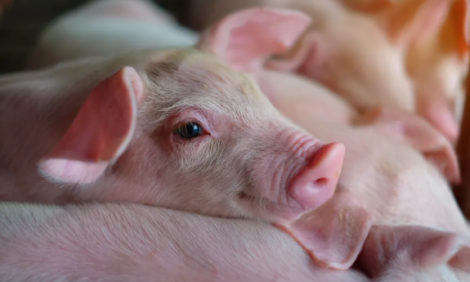



European Union - Livestock and Products Annual 2009
Total EU pig production in 2009 is expected to be the lowest since 2000. However, current high pig prices indicate that the pig cycle will bottom out in 2010, according to the latest GAIN report from the USDA Foreign Agricultural Service.Executive Summary
In 2008, high feed prices forced the most inefficient farmers to quit. As a result of the shrinking production, prices for slaughter hogs increased to the highest level in seven years, in which combination with falling feed prices improved profitability of fattening during the second half of the year.
The financial crisis had, however, a detrimental effect on domestic and export demand for pork. Due to the limited export opportunities, lower domestic supply, and absence of EC support, pork exports are forecast to fall nearly thirty per cent in 2009. With the financial crisis and the expectation that feed prices will not return to the lower level of before 2007, margins on fattening pigs are expected to remain tight.
In 2009, the total EU piglet production is expected to fall to the lowest crop reported since 2000. The current high piglet prices are, however, an indication that the swine cycle will bottom out in 2010. After a cut-back of 2.5 per cent in 2008, and 1.6 per cent in 2009, the pig crop is expected to recover by 0.7 per cent in 2010.
A recovery of slaughter and thus pork production is not yet expected in 2010.
2008: High Feed Price Forced Inefficient Farmers to Quit
As anticipated in the previous Annual Livestock Report (E48094), the EU pig crop declined significantly in 2008.
One of the main factors for this decline was the high feed price which affected profitability. The tight margins forced the most inefficient farmers to quit, in particular breeders. While the carcass prices remained well above the five-year average, piglet prices were reported below the five-year average during the first half of the year (see graph below).
With a reduction of about twenty per cent, or 5.5 million head per annum, pig production shrunk most significantly in Poland (see GAIN Report PL8028). Beside the high feed price, competition from in particular Denmark forced Polish farmers to quit. Significant reductions were also reported in Denmark, Spain and Hungary. Due the dim market conditions, the fattening period was shortened, which reduced the average slaughter weight in 2008.
As a result of the shrinking production and thus increased import demand of pork in mainly the New Member States (NMS), the price for slaughter hogs increased to the highest level in seven years. The high carcass prices, and falling feed prices, improved profitability of fattening in most EU Member States during the second half of the year. During 2008, the EU pig stocks fell from 159.7 million head to 153.0 million head.


2009 & 2010: Swine Cycle Expected to Bottom out in 2010
The record carcass prices could not be maintained during 2009. Due to the financial crisis, which cut consumer expenditure on domestic and export markets, carcass prices declined to the five-year average during the first two months of 2009.
Due to these dim market conditions and the expectation that feed prices will not return to the lower level of before 2007, margins on fattening are expected to remain tight. As a consequence, the restructuring of the intensive pig sector is expected to continue. Restructuring will imply termination of the most inefficient farms throughout the EU and reduction of backyard farming in mainly the NMS. This process will imply an increase in the number of piglets per sow, but an overall cutback of the EU pig crop and slaughter.
The most significant reduction in piglet production is expected in the EU-15, in particular in the Benelux countries, Spain and Germany. In the NMS, most of the cutback took already place in 2008. Total EU piglet production is expected to fall 1.6 per cent, from 258.4 million head in 2008 to 254.3 million head in 2009, which is the lowest crop reported since 2000.
As a result of the lower supply, piglet prices rose to the highest level in three years. The high piglet prices are an indication that the swine cycle, expressed as piglet production, will bottom out in 2010.
Due to a strong recovery in Poland, total EU production is even expected to increase by 0.7 per cent to about 256 million piglets. Both the Polish and Danish production are supported by exports of live slaughterhogs to Russia. Russian imports of slaughterhogs from the EU increased from about 25,000 head per month in 2007, to 50,000 head per month in 2008, and increased to 75,000 head per month during the first half of 2009. The good EU grain and oilseed crop is expected to benefit piglet production throughout the EU. Due to the fattening period, a recovery of slaughter and thus pork production is not expected in 2010. After the cutback of the EU pig stock in 2008 and 2009, the stock is forecast to stabilize at 149.3 million head in 2010.
2008 EU pork Exports Rose to Record Level
The elevated supply of pork in 2007, in combination with EC funding, boosted EU pork exports in 2008, to a record level of 1.7 million metric tons (MMT). Exports increased most significantly to the Ukraine, China, Belarus and Russia.
The export refunds, for most fresh/frozen products €100 per metrc ton (MT), were terminated on 8 August 2008. With the lower slaughter and diminished Private Storage Aid (PSA) stocks, the EU pork supply tightened during 2008. In 2008, EU pork meat imports from the United States more than doubled to 48,000 MT (US Customs data). Most of the US pork meat is exported to the EU by Smithfield which purchased several EU pork processors in recent years.

2009 & 2010: Exports Forecast to Fall Due to Limited Supply and Export Demand
Due to reduced slaughtering, EU pork production is expected to decline from 22.6 MMT in 2008 to 22.0 MMT in 2009, a reduction of 2.6 per cent. The most significant cut-backs are anticipated in Poland and Denmark. As the swine cycle is expected to bottom out in 2010, the cut down in EU pork production is expected to be limited in that year: only about 0.5 per cent to 21.9 MMT.
In none of the EU Member States is a significant production recovery anticipated. In Poland, a slight increase is expected, which is supported by the strong import growth of piglets from mainly the Netherlands. A major upturn of piglet and pork production is impeded by the financial crisis that reduced demand from the export markets.
During the last quarter of 2008 and first quarter of 2009, EU exports to Russia and Ukraine plummeted. Exports to Russia are also uncertain due to veterinary issues and new import quotas (see policy section). As a result of the limited export opportunities, lower domestic supply and absence of EC support, 2009 and 2010 pork exports are forecast to fall below the level of 2008 and even of 2007 (1.29 MMT). It is unlikely that the EC will impose support measures such as intervention or export restitutions.
A positive factor is that the weakened currency of some NMS, such as Poland, might have a positive effect on their pork exports. The main net pork exporting countries, mainly the Benelux countries, Denmark and Germany, are increasingly focusing on the European market, in particular Central Europe. Due to increased domestic prices and restricted consumer budgets, however, pork consumption is expected to decline in the NMS. In north-western Europe, an important factor for the stagnating pork consumption is the increasing popularity of poultry meat. In this market, the financial crisis has only a limited effect on total pork consumption, except the trend of consumers shifting from buying expensive parts to the cheaper parts.

EU Pig Sector Still Lobbying for Subsidies
EU pig prices decreased at the end of 2008 and dropped further during the first months of 2009. Pig producers have continued asking the EC to provide support for the EU pig sector by means of renewed intervention and export subsidies. However, it is unlikely that the EC will grant export subsidies due to the tight supply of pork on the domestic market.
Problems with EU Exports to Russia
During 2009, EU exports of pork to Russia are suffering from Russian import restrictions after they had soared in 2008. Due to alleged violations of strict new Russian residue limits, hundreds of EU meat exporters were de-listed for exports to Russia. Export plants gained Russian export eligibility again only after adopting new Russian food safety standards. Russia has also decreased its import quota for 2009in a bid to boost domestic production.
EU Disease Situation
European consumption of pork was barely impacted by the outbreak of the H1N1 influenza in Mexico and the United States. The outbreak does, however, impact the EU pork market as Russia immediately put a ban on pork exports from Spain and the United Kingdom. The ban on Spanish pork was lifted again on 3 June 2009 after Spain held bilateral negotiations. The ban on UK pork is meaningless as the ban imposed after the foot and mouth disease (FMD) outbreak is also still in place.
Further Reading
| - | You can view the full report by clicking here. |
December 2009








